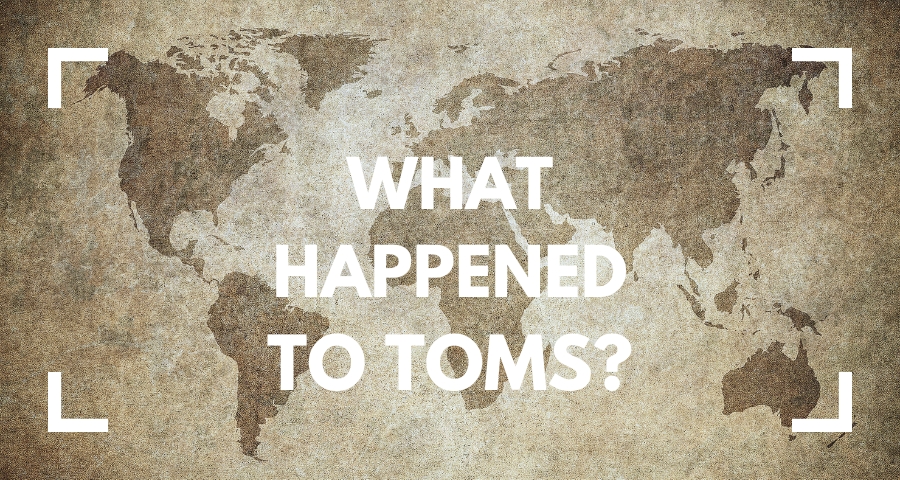One decade ago, TOMS was stepping toward world domination. The footwear brand was known for its distinct espadrilles and its “buy one, give one” model. Each time someone bought a pair of shoes, another pair was donated to a child in need.

In the early 2010s, wearing TOMS was a statement that meant that you were fashionable and philanthropic. The brand was valued at $625 million in 2014, but by 2019, creditors took over the company. The company had a $300 million loan due in 2020, and it wasn’t expected to be able to pay it off.
Like most fashion trends, TOMS doesn’t seem to be infinitely popular. But, it hoped its charitable efforts would prolong its favor in the public’s eye. Despite this, the shoes are far less popular than they were in prior years. You can still buy them, but there are many reasons why people are spending their dollars elsewhere.
Fashion is fickle
TOMS offers its customers a variety of products including different shoe styles and glasses — it even sold coffee at one point. However, it’s primarily recognized for the Alpargata shoe, which once made up roughly 50% of its sales.
It seems TOMS’ signature styles are becoming dated, and it’s forcing the company to pivot into different offerings like sneakers. This still falls under the footwear umbrella, but it does represent a new image for the brand.
However, the brand can’t stray too far from its identity. It’s known for offering sustainable shoes (though not all styles are vegan), and those values are core to its customer base. TOMS is trying to strike a balance of being fashion-friendly while still retaining its brand identity and sticking to its eco-friendly values.
It’s easy to copy
When people think of TOMS, one style likely comes to mind: The brand is synonymous with the canvas slip-on espadrille. It’s a cheap, easy shoe to make, but there’s a problem: TOMS doesn’t own this design.

Most notably, Sketchers introduced BOBS in 2010, and it essentially template-matched TOMS’ business model. It offered nearly-identical shoes, a buy-one, give-one model, and made its products from sustainable materials. This made the TOMS brand feel less exclusive and allowed the espadrilles market to become saturated.
That’s not to mention that department stores had their knock-offs, and you could easily buy a TOMS impostor on Amazon, presumably for a fraction of the cost. So, if customers wanted TOMS style without the brand-name price, they had options.
They’re not super durable
If you want people to be seen wearing your shoes, they need to be able to keep them on their feet. TOMS aren’t known for having an exceptionally long life, though this isn’t a dig at the brand’s quality. Anyone familiar with espadrilles knows they’re meant for easy, casual wear — not heavy movement or strenuous walking. While the lifespan of a pair of shoes depends on how often a person wears them, most customers wore through a pair in a year, if not sooner, before replacing them.
Eventually, the replacement cycle will end, and customers will move on to a different shoe — whether it’s because they’re looking for a new style or they’re tired of buying replacements. Even if you’re OK with buying new shoes, you need to wonder how long donated shoes will last if their recipients are using them as their primary footwear.

People don’t care that much about charity
The concept of giving a pair of shoes to a child in need sounds nice, but is it enough to persuade people to buy TOMS over another brand? Probably not. It takes about $10 to make a pair of shoes — double that for the shoes that are donated — and any price over $20 goes toward the company’s profit.
Seemingly, customers stopped wanting to give debatably-fashionable, moderate-quality shoes to people in need. In recent years, the brand moved away from its buy-one, give-one model. Instead, it donates one-third of its net profits to grassroots organizations.
This is because people don’t want to blindly “do good.” The new model is an attempt to win over Gen Z and donate to causes that matter most to them, such as nonprofits focusing on mental health, equal access to employment, and ending gun violence. When TOMS were first popular, it seemed like many nonprofits focused on causes in Africa (think KONY 2012 or Save Darfur). At the end of the 2000s, the brand aligned with relief efforts in Africa, but now, different philanthropic causes dominate conversations.
Will TOMS make a comeback?
At the moment, it feels like TOMS is still struggling to find its footing in the current market. One indication of this is the fact that it donated 15% less to its partners in 2022 than it did in 2021. But, the decline is unlikely due to its donation model and is more likely to be a result of its offerings.
Recently, the brand noted that it had difficulty adapting as customer trends favored sneakers. While addressing this shift the brand is also introducing variations of its Alpargata. So, don’t expect TOMS to abandon its core product any time soon, even if it’s to its own detriment.
Not all hope is lost. Other brands from the 2000s have managed to make comebacks; just look at UGGS or Crocs. It seems possible that TOMS could follow a similar trend and become cool again. Until then, the brand will need to stay afloat. Recent changes seem to be safe efforts and have had minimal impact on its success. So, if you don’t hear any big news from TOMS, don’t expect to see people wearing them again any time soon.






You must be logged in to post a comment.